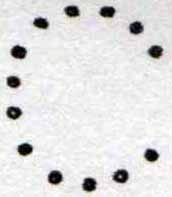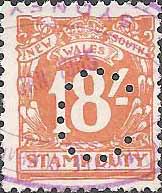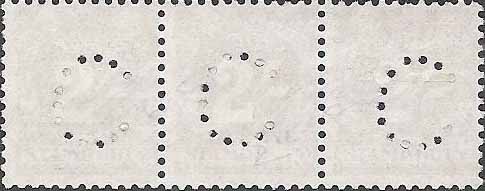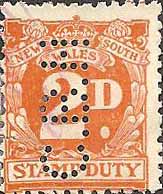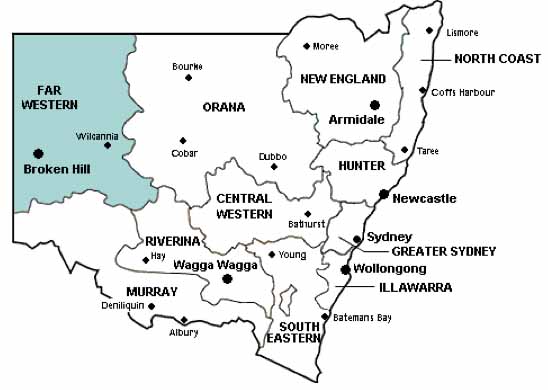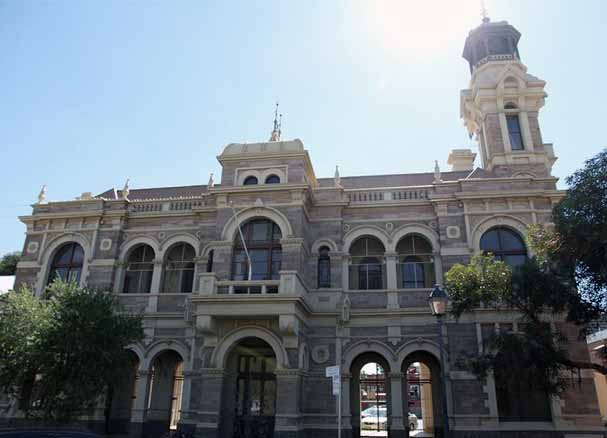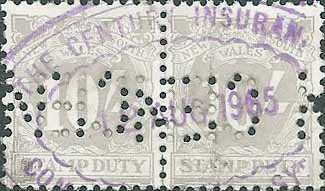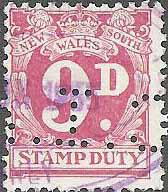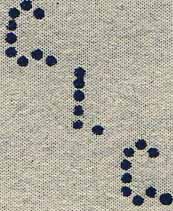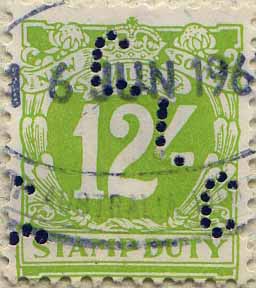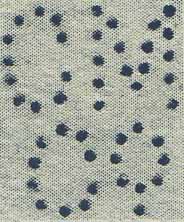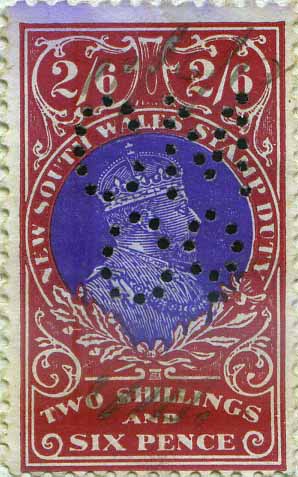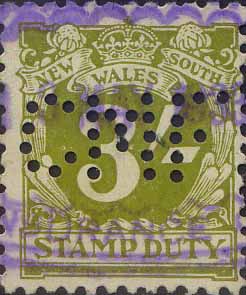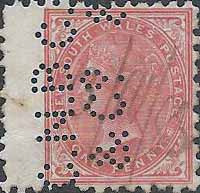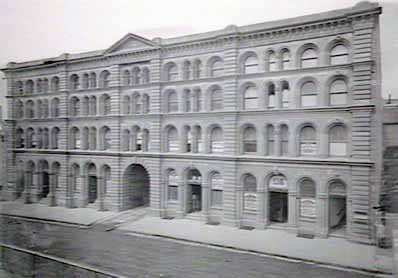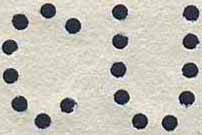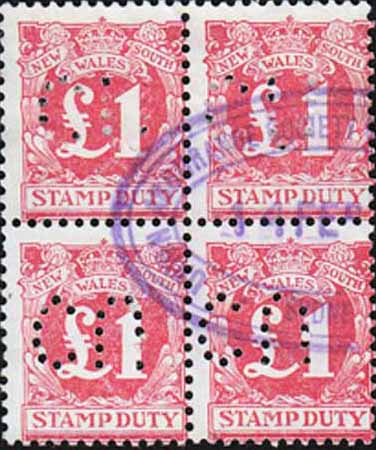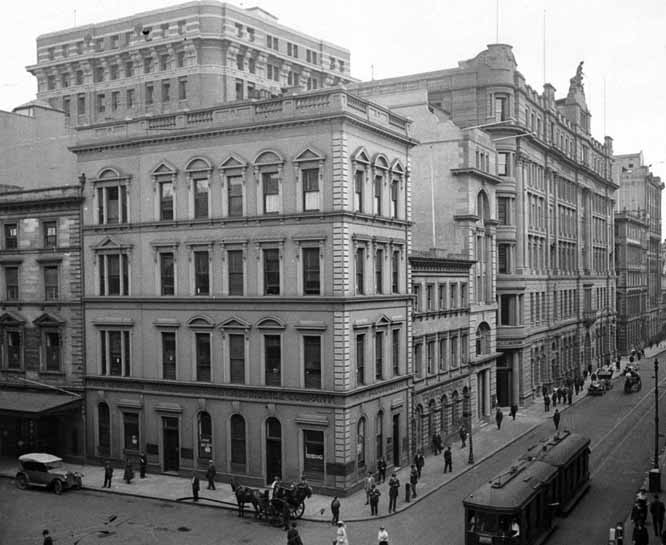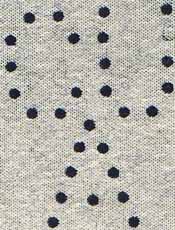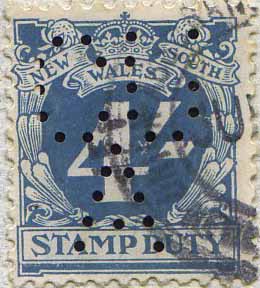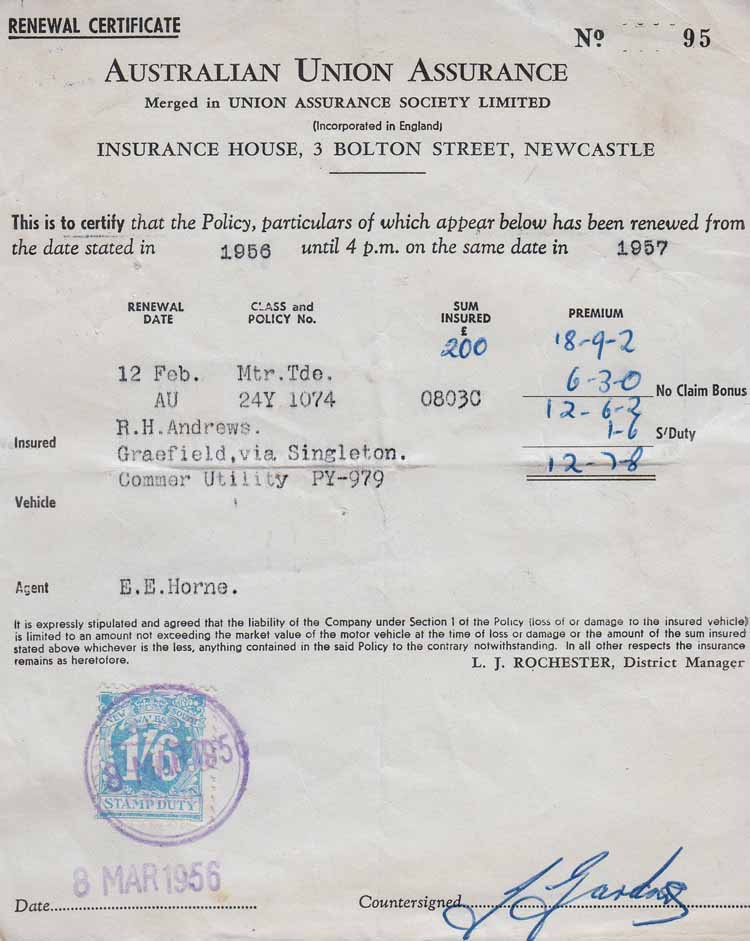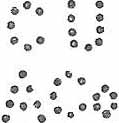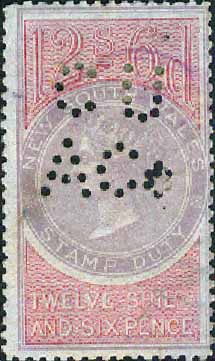|
Private Revenue Perfins of New South Wales An Elsmore Coath production The authors would welcome your comments additions or input into this work A B C D E F G H I J K L M N O P Q R S T U V W Y Other C -------------------------------------------------------- C.a
User: Constable and Company
Share Brokers
Address: 25 O’Connell St, Sydney NSW Revenue Use: Numeral
1929-66
issue 3d, 6d, 9d, 1/-, 1/6,
2/-, 2/6, 3/-, 4/-, 5/-, 6/-, 8/-[brown], 10/-,
12/-, 14/-, 16/-, 18/-, £1, 30/-, £5, £10 Decimal 1966 8c, $3 Rarity Scale: Numeral 1929-66 issue 3d R2, 6d
R2, 9d R2, 1/- R1, 1/6 R2, 2/- R2, 2/6 R3, 3/-
R2, 4/- R2, 5/- R2, 6/- R2, 8/-[brown] R4], 10/-
R2, 12/- R3, 14/- R3, 16/- R4, 18/- R3, £1 R1,
30/- R2, £5 R4, £10 R4 Decimal 1966 8c R4, $3 R4 Background: *In 1961 David Constable formed the Stock Broking firm Constable and Co and took a seat on the Sydney Stock Exchange. Constable and Co traded until 1971 when they merged with Rudd, Bain, McDonald and Co to become Constable and Bain.
Device: The C.a device is most likely a a single die device as multiple strikes do not show a consistent relationship to each other.
The same C.a pattern is found on revenue stamps of NSW, Queensland and Victoria but Constable and Company seem to have operated exclusively from Sydney so these C patterns are most likely all strikes for the same Sydney device. This same practice was used by other Stock Brokers refer Meares and Bishop (M&B.a) and Ord and Minnett (O&M.a/.b) in this NSW chapter.
This C pattern is only found used on revenue stamps and only for a relatively short period in the 1960’s between 1962 and 1967. A word of caution about the pattern, despite its regular appearance the curve of the C is not consistent and it will not overlay over the perfin finder and reference pattern unless in position 1. So if you fail to get a match with your example against the reference pattern then turn it over and try from the other side.
Related patterns: Refer to other Constable and Company, C, patterns in:
QLD: C.a
VIC: C.a
*’Sydney Stockbrokers’ Salsbury and Sweeny (1992)
-------------------------------------------------------- C.B.H.a
User: Council Broken Hill City Council Broken Hill Address: Broken Hill, NSW Revenue Use: Numeral 1929-66 issue 2d, 3d Rarity Scale: Numeral 1929-66 issue 2d R4, 3d R3 Background: *Broken Hill is an isolated mining city in the far west of NSW near the border with South Australia and it is reputed to be Australia's longest-lived mining city. The area around Broken Hill was first visited by NSW Surveyor General, Major Mitchell, in 1841 and in 1844 the explorer Charles Sturt named the Barrier Range and a feature he referred to as the 'Broken Hill' in his diary. Pastoralists started moving into the area in the 1850’s, but the area did not come to prominence until Silver and Lead deposits were discovered by a boundary rider named Charles Rasp in 1883. In 1885 the Broken Hill Proprietary Company (BHP), (today BHP Billiton) was formed to mine the ore body which contained the world's richest deposits of lead, zinc and silver. The company continued to mine in the area until February 1939 however by that time there were other mining interests in the region and these continued to mine both north and south of the original BHP site and these activities still yield around two million tonnes annually. As mining has faded it has been replaced by sheep farming and the area holds almost two million head of sheep. Broken Hill’s isolation was a problem until 1888 when the South Australian Government built a narrow gauge railway link from Adelaide to the SA/NSW border. However the NSW Government would not allow the railway to cross the border and so the last 30 km between SA/NSW border and Broken Hill was built by a private company known as the Silverton Tramways. The railway formed a vital link that allowed concentrates and ores from the mines to be shipped to the smelters and port facilities on the coast at Port Pirie (SA). Later In 1919, a standard gauge link was established from Broken Hill to Menindee and this became a direct link to Sydney in 1927.In 1970 the link between Broken Hill and Port Pirie was converted to standard gauge and it became part of the link between Sydney and Perth. Broken Hill became a municipality in 1888 and the foundation stone for the town hall was laid by Sir Henry Parkes in 1890. In 1907 Broken Hill was declared a City.
Device: The CBH.a device was most likely a single die device, although due to its rarity we have sighted no multiples that would provide any conclusive evidence of this. The device has the ability to produce central strikes in a variety of positions and this and the consistent nature of the pattern are indications of a single die device. The pattern is found on the revenue stamps of NSW as well as the postage stamps of Australia in the short period around 1923. All the strikes we have seen of this CBH.a device are clear and consistent so it is difficult to see why its use was discontinued. Related Patterns: Nil
City of Broken Hill, old Town Hall, Argent St, Broken Hill *Wikipedia *NSW State Records -------------------------------------------------------- CEN.a
User: Century Insurance Co Insurance Provider Address: ‘Raine Chambers’ 70 Pitt St, Sydney, NSW Revenue Use: Numeral 1929-66 issue 3d, 1/-, 1/6d, 3/-, 6/-, 10/-, £1 Decimal 1966 1c, 6c, 8c, 15c, 40c, $1, $2, $3 Rarity Scale: Numeral 1929-66 issue 3d R4, 1/- R1, 1/6d R4, 3/- R4, 6/- R4, 10/- R3, £1 R4 Decimal 1966 1c R4, 6c R4, 8c R4, 15c R4, 40c R4, $1 R4, $2 R4, $3 R4 Background: *The Century Insurance Company Limited were incorporated in England in April 1885 and expanded throughout Africa, India and East Asia as well as Australia. They arrived in Australia in the early 1900’s and established branches firstly in Melbourne and Sydney (18 Bond St) but later in Adelaide (1928) and Brisbane (1929). In the early 1950’s the company expanded their Australian operation with the purchase of key properties in Sydney, ‘Raine Chambers’ 70 Pitt St and in Melbourne at 101 Queen St. The company was ultimately absorbed into the RSA Royal Sun Alliance group in the 1990’s. Device: The CEN.a device is a single die device and multiple strikes show no consistent relationship to each other. The pattern is only found on the revenue stamps of NSW and only in the period from 1965-1966. Related Patterns: Refer to Royal Insurance patterns in RI/Co.a for a full listing of these related patterns. Royal Insurance group *Trove -------------------------------------------------------- C.I..a
User: Unknown Revenue Use: Numeral 1929-66 issue 9d Rarity Scale: Numeral 1929-66 issue 9d R4 Background: Unknown Device: This is a new pattern previously unreported (as of 3/2013). The sole known example shows use on a NSW revenue from 1955. The C is incomplete but there is evidence of another C of an unrelated strike on the left hand side of the stamp. This indicates that it is most likely a single die device with just the letters 'C.I.' Related Patterns: Nil -------------------------------------------------------- C.I.C..a
User: The Cooperative Insurance Co of Australia Ltd Insurance Provider Address: ‘Temple House’ 2 Bligh St, (Cnr Bent & Bligh St's), Sydney, NSW Revenue Use: Numeral 1929-66 issue 6d, 9d, 1/6, 3/-, 5/-, 6/-, 8/-[brown], 8/-, 12/-, £1, 30/- Rarity Scale: Numeral 1929-66 issue 6d R4, 9d R4, 1/6 R4, 3/- R4, 5/- R4, 6/- R4, 8/-[brown] R4, 8/- R4, 12/- R4, £1 R4, 30/- R4 Background: *The Co-operative Insurance Co of Australia Limited is not to be confused with The Co-operative Insurance Company (UK) which was formed in Manchester in 1867 and subsequently grew into a multi national company with branches throughout the old British Commonwealth including Australia. The English company is generally referred to as CIS where the Co-operative Insurance Company of Australia is referred to as CIC. The Co-operative Insurance Co of Australia Limited seems to have been started in Sydney in around 1911 but some sources claim that it was started in Melbourne in the early 1920’s. In any case it was listed as a Workers Compensation provider from the mid 1920's in both Melbourne and Sydney. The company had a relationship with both the British Commonwealth Insurance Co. Ltd. and Legal and General Assurance Society Ltd. and it appears most likely that they were acquired by one of these companies in the 1950’s. Given that Legal and General had acquired British Commonwealth Insurance it is more likely that Co-operative were also acquired by Legal and General as the trend in the insurance business in the 20th century was for larger companies to absorb smaller ones. At the time of the use of the CIC.a device the three insurers were most likely collocated at Legal and General’s premises at 'Temple House' at 2 Bligh St on the corner of Bent St. Late usages of the BC.a device of British Commonwealth Insurance (1965-66) sometimes carry cachets of The Co operative Assurance Co of Australia Limited. Device: The CIC.a device is a single die device as multiple strikes do not show any consistent relationships to each other. The pattern being in a diagonal format is uncommon and the pins are numerous, relatively thick and close together. Strikes are not always clear and missing or blocked pins are common. It is difficult to gain an appreciation of whether these characteristics were associated with the degradation of the device as the usage period is so small, limited as it is to 1965. The pattern is only found used on the revenue stamps of NSW. Related patterns: Refer to other Legal & General related company patterns in:
NSW: BC.a G.a LG.a *Trove -------------------------------------------------------- CM/Co..a
User: City Mutual Fire Co Ltd Insurance Provider Address: 95 Pitt St, Sydney, NSW Revenue Use: QV 1872-1908 issue 6d, 1/-, 1/6, 2/-, 2/6, 3/-, 4/-, 5/-, 8/-, 10/-, 15/-, £1 QV 1880-1902 issue 3d, 9d KEDVII 1909-28 issue 1d, 2d, 3d, 4d, 6d, 8d, 9d, 1/-, 1/6, 2/-, 2/6, 3/-, 4/-, 5/-, 6/-, 10/-, £1 Crown A inv wmk 8d, 2/-, 2/6, 3/- Blue paper 1/6, 1/-, 2/-, 4/- Rarity Scale: QV 1872-1908 issue 6d R1, 1/- R1, 1/6 R3, 2/- R2, 2/6 R3, 3/- R3, 4/- R4, 5/- R2, 8/- R4, 10/- R3, 15/- R4, £1 R4 QV 1880-1902 issue 3d R2, 9d R3 KEDVII 1909-28 issue 1d R4, 2d R4, 3d R3, 4d R2, 6d R3, 8d R3, 9d R4, 1/- R1, 1/6 R4, 2/- R2, 2/6 R2, 3/- R2, 4/- R4, 5/- R2, 6/- R4, 10/- R3, £1 R4 Crown A inv wmk 8d R4, 2/- R4, 2/6 R4, 3/- R4 Blue paper 1/6 R4, 1/- R2, 2/- R4, 4/- R4 Background: *The City Mutual Fire Insurance Company Limited was formed in Sydney in 1878 by James P Garvan and established a head office in Sydney and a branch office in Brisbane that year. In 1894 they acquired the Sydney Mutual Company and by the early 1900’s they had expanded to also have branch offices in Melbourne (1897), Adelaide and Perth. Garvan was a businessman and politician who had been born in Ireland in May 1843 and had migrated to NSW with his family in 1847. After leaving school in 1860 he initially worked with the Sydney Municipal Council but later trained as a lawyer. In 1876 he turned to commercial interests in Insurance and Ferry transport. Garvan then started the Terminating Building Society and in 1876 established and ran the North Shore Steam Ferry Co Ltd. before founding a series of Insurance companies including the City Mutual Fire Insurance Co Ltd. the City Mutual Life Assurance Society Ltd. as well as the Citizens’ Life Assurance Co. Ltd which specialised in industrial assurance. Garvan represented Eden in the NSW Legislative Assembly between 1882 and 1894 and was for a short period Colonial Treasurer. He died on 20 November 1896 however he was succeeded by his eldest son John Garvan (Later Sir John) who in 1897 became General Manager and a Director of the Citizen's Life Assurance. Co Ltd, and in 1899 Managing Director John Garvan was instrumental in helping the troubled Australian Widows' Fund and the Mutual Life Association of Australasia by amalgamating them with the Citizens’ Life Assurance Co Ltd. to form the Mutual Life and Citizens' Assurance Co Ltd (MLC) in 1908. Further John Garvan oversaw the acquisition of the City Mutual Fire Insurance Company Limited by the much larger London and Lancashire Insurance Company in 1898. As is generally the case with insurance companies City Mutual Fire Insurance Company Limited continued to trade under its own name but they were collocated with London and Lancashire Insurance at their offices at 95 Pitt St, Sydney. Device: The CM/CO.a device produced a large pattern and this is in keeping with the generally larger format revenue stamps of the period including the Queen Victoria (QV) and Edward VII bi colours that were in use until 1928. When applied to the smaller format QV stamps it almost always appears as a partial due to the size of the die. The pattern is found as a single central strike on large format stamps in positions 1 and 2 and accordingly it is most likely a single die device. The pattern is found used on the revenue stamps of NSW and very rarely on the postage stamps of Australia. Usage on postage stamps is very limited and only in the period 1925-1927 which is peculiar as the company was known to have applied to the NSW Postmaster General in 1888 to use a perforating device, however there is no record of an approval. The usage on revenues is very widespread from as early as 1890 until at least 1927. Examples of usage from the mid 1920’s show many incomplete strikes suggesting that the device was not in good order. Related Patterns: Refer to related company patterns in NSW: AAA/Co.a D.T..a LL.a LL/Co.a Other – Section 2 Commercial Perfins and Cancelling Devices CITY/MUTUAL/FIRE/INSURANCE/Coy.a London and/Lancashire/FIRE/Insurance/Company.a *Trove *Australian Dictionary of Biography -------------------------------------------------------- CMF.a
User: Colonial Mutual Fire Insurance Co Insurance Provider Address: 74 Pitt St, Sydney, NSW Revenue Use: Numeral 1929-66 issue 3d, 4d, 6d, 9d, 1/-, 1/6, 2/-, 2/6, 3/-, 4/-, 5/-, 6/-, 10/-, 14/-, £1 Rarity Scale: Numeral 1929-66 issue 3d R3, 4d R4, 6d R4, 9d R3, 1/- R1, 1/6 R4, 2/- R3, 2/6 R3, 3/- R4, 4/- R3, 5/- R3, 6/- R3, 10/- R4, 14/- R4, £1 R4, 30/- R4 Background: *The Colonial Mutual Life Assurance Society Limited was formed in Melbourne in 1873 but due to its status as a mutual assurance company (that is a company owned by its policy holders providing life insurance), under the Legislation of the time it was unable to offer other insurance products. Therefore it formed a separate limited liability company in 1878 to offer other insurance products, this was the Colonial Mutual Fire Insurance Company Limited. Initially the head office for the company was at 85 Collins St, Melbourne, but within a few years it moved to 601 Market St, Melbourne and remained their until the 1940’s when it moved to 405-407 Collins St, Melbourne.
The Sydney office was established in the 1890’s at 114 Pitt St, Sydney but in 1924 the company built new premises at 74 Pitt St, Sydney.
The company also quickly established branch offices in all capital cities of Australia and agencies and representatives in regional towns. Over time their product offerings grew from fire insurance to related building protection but by the 1940’s the company was offering a broad range of products including, Fire, Marine, Accident, Workers' Compensation, Plate glass, Burglary, Motor Car, Fidelity Bonds, House Owners' and Householders' Insurance. Device: The CMF.a device is one of a 3 similar devices used by the company in Australia, CMF.a was used in Sydney and the other 2 devices were used at the companies head office in Melbourne, one from 1930-1946 and the other from 1947-1964. CMF.a is however the only device that is found used on revenue stamps. CMF.a is distinctive because it has a slight indent in the back of the C. CMF.a is found used on the revenue stamps of NSW and the postage stamps of Australia over the period 1930-1962. CMF.a is most likely a single die device as multiple strikes do not show any consistent relationship to each other and further the device is able to produce single central strikes in stamps of a variety of formats. Related Patterns: Refer to other Colonial Mutual company patterns in: NSW: Other – Section 2 Commercial Perfins and Cancelling Devices CML.a *Trove -------------------------------------------------------- C.N.B/&Co..a
User: Christopher Newton Brother & Co Warehousemen Address: ‘Vickery's Buildings’ 80-84 Pitt St, Sydney, NSW Revenue Use: QV 1880-1902 issue 2d QV 1882 fiscal issue 1d Rarity Scale: QV 1880-1902 issue 2d R1 QV 1882 fiscal issue 1d R4 Background: *The company Christopher Newton, Brothers (some sources say Brother) and Co, started as a small retail drapery run by Christopher Newton, but he was soon joined by his brother Thomas Newton, and from around 1850 they operated out of premises in the ‘Beehive’ in Pitt St trading as ‘Newton Brothers’. In the early 1860’s Thomas died and Christopher embarked on an expansion moving to larger premises in Pitt St and importing large amounts of stock from England. Initially the company flourished however in 1867 it encountered financial troubles and had to be restructured and during this difficult period Christopher faithfully met his obligations to his, mainly English, creditors. Initial with part payment but later in 1881 all monies owing were paid in full. Newton returned to England in 1884 but died there in October 1885 aged 68. The company continued to be run by his sons, John, Christopher (junior), Sydney, William and J E Daly. The fact that the brothers all worked in the company gives support to the name being more likely ‘Christopher Newton, Brothers and Co’. The company occupied the ‘Vickery’s Buildings’ in Pitt St from 1867. In 1893 the company again encountered financial problems and they closed their doors in March 1893.
‘Vickery's Buildings’ 80-84 Pitt St, Sydney, built 1864 Device: The CNB/&CO.a device is found used on the revenue stamps of NSW as well as the postage stamps of NSW over the period 1883-1893. This is quite early use of a perforating device and is most likely the first use of such a device in Sydney. The device is not listed in Slopers work books but is characteristic of the style of English devices and given the companies buying relationships in England this is the most likely source of the device. The device was a single die device as there is no consistent relationship between strikes on examples with multiple strikes. Related Patterns: Nil *Trove -------------------------------------------------------- CU.a
User: Commercial Union Assurance Co Insurance Provider Address: 34-36 Hunter St, Sydney, NSW Revenue Use: Numeral 1929-66 issue 3d, 4d, 6d, 6d[no wmk], 8d, 9d, 1/-, 1/6, 2/-, 2/6, 3/-, 4/-, 5/-, 6/-, 8/-[brown], 8/-, 10/-, 12/-, 14/-, 16/-, 18/-, £1, 30/- Decimal 6c, 15c, 80c, $1, $2 Rarity Scale: Numeral 1929-66 issue 3d R4, 4d R4, 6d R3, 6d[no wmk] R4, 8d R4, 9d R4, 1/- R3, 1/6 R1, 2/- R2, 2/6 R3, 3/- R1, 4/- R3, 5/- R1, 6/- R2, 8/- R4, 10/- R3, 12/- R4, 14/- R4, 16/- R4, 18/- R4, £1 R2, 30/- R4 Decimal 1966 6c R4, 15c R4, 80c R4, $1 R4, $2 R4 Background: *The Commercial Union Assurance Company was established in London, England in 1861 following a serious fire known as the ‘Tooley St fire’, which destroyed warehouses and wharves in London and resulted in significant premium increases. Provisionally called the Commercial Union Fire Insurance Company, the company was established to transact fire business, but soon the company added life assurance (1862) as well as overseas fire insurance and marine in 1863. In 1900, the company expanded its business to include burglary and accident insurance followed by plate glass insurance in 1901 and a trustee and executor business by 1905.
At the same time the company expanded it branches both at home and abroad with 82 offices in England and a presence in every continent with over 70 overseas agencies. The company established itself in Australia first in Sydney and Melbourne (1863), followed by Adelaide (1865), Brisbane and Hobart (1879) and Perth (1892).
The company continued to grow in Australia and internationally through mergers and acquisitions, which was a characteristic of the insurance business in the 20th century. Evidence from company cachets indicates that Ocean Accident and Guarantee were one of those companies acquired by Commercial Union and another was the Australian Mutual Fire Insurance Society Ltd in 1921.
Around the same time the Commercial Union Assurance Company also acquired Union Assurance Society of Australia Ltd (see UAS.a) and their subsidiary companies including Australian Union Assurance, although Union Assurance continued to trade under its own name.
The Commercial Union Assurance Company is not to be confused with The second Commercial Union Assurance Company was incorporated on 17 March 1871 as the Merchants' Marine Insurance Company Ltd. and only became part of Commercial Union Assurance Company in 1968 and was dissolved in September 2007.
Commercial Union Assurance Company merged with General Accident in 1989, however evidence from company cachets indicates that the companies were working very closely together since the 1960’s.
In October 1999, the company changed its name to CGU International Insurance and later in February 2000, CGU announced a merger with Norwich Union to form CGNU, which was re-branded in July 2002 as Aviva International Insurance.
Device: The CU.a device is a single die device, as multiple strikes do not show any consistent relationship to each other.
The device is only found used on the revenue stamps of NSW and only in the period from 1947 until 1966.
Late use from the mid 1960’s does show some consistent missing pins, particularly in the back of the C and the base of the U.
Related Patterns: Refer to other related company patterns in:
NSW: AMF.a CU/A.a CU/&CO.a OA.a UAS.a
QLD: Other – Section 1 Commercial Perfins and Cancelling Devices
O.A. & G.C. LTD/ BRISBANE.a
*Aviva website
*Trove -------------------------------------------------------- CU/A.a
User: Commercial Union Assurance Co Insurance Provider Address: Insurance House, 3 Bolton St, Newcastle, NSW Revenue Use: Numeral 1929-66 issue 3d, 6d, 9d, 1/-, 1/6, 2/-, 2/6, 3/-, 4/-, 5/-, 6/-, 10/-, £1 Decimal 1966 8c, 40c, $2 Rarity Scale: Numeral 1929-66 issue 3d R4, 6d R3, 9d R4, 1/- R3, 1/6 R4, 2/- R3, 2/6 R3, 3/- R3, 4/- R4, 5/- R4 6/- R4, 10/- R4, £1 R3 Decimal 1966 8c R4, 40c R4, $2 Background: See CU.a. Device: From postmark evidence on postage stamps, the CU/A.a device appears to have been located in Newcastle, but we have been unable to determine the exact location of the companies Branch office in that city. Furthermore the device usage overlaps with CU.a which supports remote usage.
The CU/A.a device was a single die device as it is known to produce single central strikes in stamps of a range of formats. The pattern is found on the revenue stamps of NSW as well as the postage stamps of Australia. Usage begins around 1941 and continues on postage stamps until at least 1955.
As is often the case usage on revenue stamps persists after use on postage stamps has ceased and the CU/A.a pattern is found on revenues until at least 1966.
The CU/A.a device has a rather large die and as a result it will often appear as a partial on smaller issues such as the Numeral issue.
Related Patterns: Refer to other related company patterns in:
NSW: AMF.a CU.a CU/&CO.a OA.a UAS.a
QLD: Other – Section 1 Commercial Perfins and Cancelling Devices
O.A. & G.C. LTD/ BRISBANE.a
-------------------------------------------------------- CU/ACo.a
User: Commercial Union Assurance Co Insurance Provider Address: 34-36 Hunter St, Sydney, NSW Revenue Use: QV 1872-1908 issue 1/-, 1/6, 2/-, 3/-, 4/-, 5/-, 7/-, 8/-, 9/-, 10/- 12/6, 15/-, £1 QV 1880-1902 issue 3d 9d Rarity Scale: QV 1872-1908 issue 1/- R2, 1/6 R3, 2/- R3, 3/- R3, 4/- R3, 5/- R2, 7/- R4, 8/- R4, 9/- R4, 10/- R3, 12/6 R4, 15/- R4, £1 R4 QV 1880-1902 issue 3d R4, 9d R4 Background: See CU.a
Device: The CU/&CO.a device was most likely a single die device as the pattern is found struck singularly and centrally in positions 1 and 2 in large format stamps such as the QV bi colours, and if it was a multi die device then we would see parts of strikes of adjoining dies, which is not the case.
The pattern is quite large and suits the larger format bi colours but is sometimes seen on the smaller format revenue stamps of the late 1890’s and early 1900’s. In these instances it generally appears as a partial strike. The pins of the device are quite thick and they remove a large amount of paper. This causes parts of the pattern with pins close to each other to sometimes break away completely, in particular the O of CO, which is often seen just as a large hole.
The pattern is only found used on revenue stamps of NSW and only over the period 1890-1902.
Related Patterns: Refer to other related company patterns in:
NSW: AMF.a CU.a CU/A.a OA.a UAS.a
QLD: Other – Section 1 Commercial Perfins and Cancelling Devices
O.A. & G.C. LTD/ BRISBANE.a -------------------------------------------------------- A B C D E F G H I J K L M N O P Q R S T U V W Y Other © copyright 2011 |
